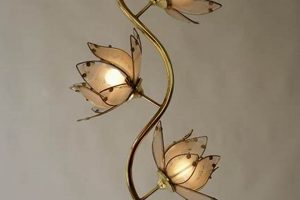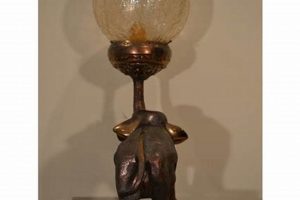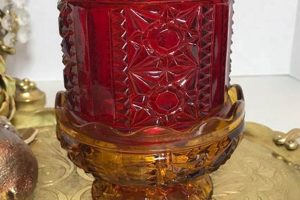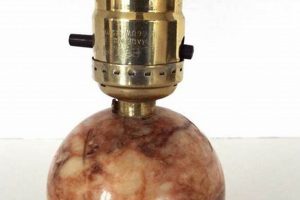Illuminating exterior spaces with fixtures from bygone eras offers a distinctive aesthetic. These lighting solutions, often crafted from durable materials such as cast iron or copper, provide both functional light and a decorative element reminiscent of earlier design periods. For instance, a restored gas-style lantern affixed to a porch can evoke a sense of early 20th-century charm.
The appeal of these historical lighting options lies in their blend of functionality and aesthetic value. They offer a connection to the past, adding character and visual interest to modern landscapes. Furthermore, many of these pieces were built to last, representing a sustainable choice compared to contemporary, mass-produced alternatives. Their historical context provides a unique ambiance, enhancing the overall atmosphere of the outdoor area.
An examination of various styles, materials, and restoration techniques associated with these items will provide a deeper understanding of their appeal and the considerations involved in their selection and maintenance. Subsequent sections will explore the nuances of incorporating such lighting into diverse architectural settings.
Considerations for Acquiring and Maintaining Exterior Illumination from Past Eras
Selecting and preserving lighting fixtures from previous periods requires careful attention to detail. Adherence to the following guidelines will facilitate the successful integration and longevity of these pieces.
Tip 1: Assess Material Integrity: Prior to purchase, thoroughly inspect the fixture for signs of corrosion, rust, or structural damage. Evaluate the condition of the metal, glass, and wiring. A detailed assessment can prevent costly repairs later.
Tip 2: Verify Electrical Compatibility: Ensure that the wiring is compatible with modern electrical systems. In some cases, rewiring may be necessary to meet current safety standards and prevent electrical hazards. Consult a qualified electrician.
Tip 3: Research Historical Accuracy: Investigate the fixture’s origin and intended use. This knowledge informs appropriate placement and ensures that the lighting complements the architectural style of the property.
Tip 4: Prioritize Weather Resistance: Given their exposure to the elements, ensure that the fixture is adequately protected against moisture, UV radiation, and temperature fluctuations. Consider applying a protective sealant or choosing materials inherently resistant to weathering.
Tip 5: Employ Gentle Cleaning Methods: Avoid abrasive cleaners that can damage the finish or delicate components. Use mild soap and water, and gently scrub with a soft cloth or brush. Regular cleaning helps to maintain the fixture’s appearance and prevent the buildup of dirt and grime.
Tip 6: Seek Professional Restoration: For heavily damaged or intricate fixtures, consider engaging a professional restoration specialist. Expertise in metalworking, glass repair, and electrical systems ensures that repairs are conducted correctly and that the fixture retains its historical value.
Tip 7: Secure Proper Installation: Incorrect installation can compromise the fixture’s stability and create safety hazards. Hire a qualified professional to ensure that the fixture is securely mounted and wired according to local codes and regulations.
By observing these considerations, the acquisition, maintenance, and integration of these fixtures can enhance the aesthetic appeal and historical value of exterior spaces. A proactive approach to preservation ensures that these artifacts continue to illuminate and inspire for generations to come.
The subsequent section will address the stylistic integration of these lighting options into various architectural settings and landscapes.
1. Material
The selection of materials in the creation of historical exterior lighting significantly impacts its longevity, aesthetic, and value. The prevalent employment of durable substances such as cast iron, copper, and brass in older designs reflects a commitment to enduring performance in outdoor environments. The inherent resistance of these metals to corrosion and weathering contributed to the extended lifespan of these fixtures. For example, cast iron posts, often utilized in street lighting, demonstrate exceptional structural integrity, with many examples surviving for over a century despite constant exposure to the elements.
The type of material dictates the appropriate restoration methods. Cast iron, for instance, benefits from techniques like sandblasting to remove rust, followed by protective coatings. Copper, on the other hand, can develop a patina over time, which is often considered desirable, and cleaning should be approached with caution to preserve this characteristic. Conversely, inappropriate material choices in reproductions can lead to premature failure. The use of thin, modern alloys, lacking the density and corrosion resistance of original materials, diminishes both the authenticity and lifespan of the product.
Understanding the properties of materials employed in the construction of these lighting solutions provides critical insights for preservation and authentication. Careful evaluation of the composition allows for informed decisions regarding restoration techniques and placement considerations, ultimately contributing to the continued functionality and aesthetic appeal of these historical artifacts. The interplay between material, design, and environment ensures the enduring legacy of these lighting pieces.
2. Style
The aesthetic character, designated as “Style”, constitutes a pivotal element in evaluating and integrating historical exterior lighting. The stylistic attributes of a fixture determine its compatibility with diverse architectural settings and contribute significantly to the overall visual impact of the illuminated space. The correct identification and appreciation of stylistic nuances are crucial for preserving historical authenticity and achieving harmonious design integration.
- Victorian Era Ornamentation
The Victorian era (roughly 1837-1901) is characterized by elaborate detailing, including intricate scrollwork, floral motifs, and the frequent use of ornate metal castings. Fixtures from this period often feature gas-style lamps converted to electricity, reflecting the transition in lighting technology. An example would be a cast iron lamppost adorned with acanthus leaf designs. Improper placement of such a piece within a modern minimalist environment would be stylistically incongruous.
- Art Deco Geometricity
In contrast, the Art Deco period (1920s-1930s) emphasizes geometric forms, streamlined shapes, and the incorporation of materials such as glass and chrome. Art Deco lighting exhibits a clean, modern aesthetic, often featuring stepped designs and stylized representations of natural elements. A geometric sconce crafted from chrome and frosted glass is a representative example. Utilizing this style in a rustic, farmhouse setting would create stylistic dissonance.
- Arts and Crafts Movement Simplicity
The Arts and Crafts movement (late 19th and early 20th centuries) promoted handcrafted designs, emphasizing natural materials and simple forms. Fixtures from this movement typically feature clean lines, muted colors, and the integration of natural elements such as wood or hammered metal. A copper lantern with stained glass panels exemplifies this style. Placing this style in a high-tech, contemporary structure may diminish its artistic impact.
- Mid-Century Modern Minimalism
The Mid-Century Modern era (1940s-1960s) embraced minimalist designs, emphasizing functionality and clean lines. Lighting from this period often features simple geometric shapes and the use of materials such as spun aluminum and molded plastic. A simple spherical pendant lamp suspended from a chain is representative. Installing this style in a Gothic Revival setting would represent a stylistic mismatch.
Comprehending these stylistic variations enables informed decisions regarding selection, placement, and restoration. The seamless integration of these lighting solutions with the overarching architectural style ensures that the illuminated spaces enhance the aesthetic character and preserve historical integrity. Careful attention to stylistic details yields a harmonious blend of past and present, enriching the visual experience.
3. Restoration
The restoration of lighting from previous eras represents a critical undertaking in preserving both historical authenticity and functional utility. Exposure to the elements, coupled with the passage of time, inevitably leads to material degradation, corrosion, and electrical component failure. Consequently, a comprehensive restoration process becomes essential to reinstate these fixtures to their original condition, ensuring their continued operation and aesthetic appeal.
The effects of neglect on lighting can be significant, potentially rendering them unusable or unsafe. Corrosion, for instance, can compromise structural integrity, while damaged wiring poses a risk of electrical hazards. The restoration process addresses these issues through meticulous cleaning, repair, and component replacement. For example, a corroded cast iron lamppost might undergo sandblasting to remove rust, followed by the application of protective coatings to prevent future degradation. Similarly, faulty wiring would be replaced with modern, code-compliant components. The value of lighting is directly proportional to the quality of restoration; poorly executed repairs can diminish the piece’s historical significance and reduce its longevity.
Understanding the principles of proper restoration is of practical significance for collectors, homeowners, and preservationists. It allows for informed decisions regarding acquisition, maintenance, and repair. Furthermore, knowledge of historical restoration techniques ensures that interventions are sensitive to the original design and materials, preserving the piece’s historical value. While challenges exist in sourcing authentic replacement parts and replicating historical finishes, the benefits of careful restoration far outweigh the difficulties. The ultimate goal is to ensure these artifacts of illumination continue to brighten spaces and serve as tangible links to the past.
4. Placement
Strategic positioning is paramount in maximizing the functional and aesthetic benefits of illuminating pieces from previous eras. The location of such lighting fixtures dictates their visibility, contribution to ambiance, and integration with the surrounding architecture and landscape.
- Architectural Harmony
The style of a structure influences the appropriate selection of outdoor fixtures. A Victorian-era residence would be complemented by gas-style lanterns or ornate sconces, while a Mid-Century Modern home would benefit from minimalist designs. Incongruent installations detract from the aesthetic appeal of both the fixture and the property. For instance, mounting an Art Deco sconce on a Colonial Revival facade creates visual discord.
- Illumination Needs
Practical considerations dictate where lighting should be installed to ensure adequate visibility and safety. Entryways, pathways, and outdoor living areas require sufficient illumination to prevent accidents and deter unauthorized access. The placement of fixtures should prioritize these functional requirements. An example is the positioning of a lamppost at the intersection of two pathways to enhance navigation.
- Landscape Integration
Outdoor lighting can be used to accentuate landscape features, such as gardens, trees, or water features. Strategic placement can create dramatic effects and enhance the overall ambiance of the outdoor space. Subtly illuminating a specimen tree or a water fountain can transform the nighttime landscape. Conversely, poorly placed fixtures can create unwanted glare or detract from natural beauty.
- Scale and Proportion
The size of the fixture should be proportional to the area it is intended to illuminate and the surrounding architectural elements. Oversized fixtures can overwhelm smaller spaces, while undersized fixtures may fail to provide adequate illumination. The scale of a lamppost should be appropriate for the height of the building and the width of the pathway. Careful consideration of scale ensures visual harmony and functional effectiveness.
By carefully considering architectural harmony, illumination needs, landscape integration, and scale, the placement of lighting fixtures can elevate both the functional utility and aesthetic appeal of outdoor spaces. Thoughtful positioning ensures that these lighting artifacts contribute to a cohesive and inviting environment.
5. Functionality
The practical utility of exterior lighting from past eras transcends mere aesthetic appeal. A comprehensive assessment of functionality encompasses illumination effectiveness, operational reliability, and adherence to contemporary safety standards. The following considerations detail critical aspects of functionality in relation to these lighting fixtures.
- Illumination Provision
The primary function of any light is to provide adequate visibility. Lighting from previous eras may utilize different technologies, such as incandescent or early electric lamps. Assessment of light output, beam spread, and color temperature is essential. For example, a gas-style lantern retrofitted with an LED bulb offers improved energy efficiency and illumination compared to its original gas-powered counterpart. Inadequate light output compromises safety and usability.
- Operational Reliability
Consistent and dependable operation is paramount. Older lighting may be prone to mechanical or electrical failures due to age and wear. Restoration should address potential weaknesses to ensure long-term reliability. A refurbished lamppost with replaced wiring and a robust control system demonstrates enhanced operational stability. Intermittent functionality diminishes the practicality and convenience of the fixture.
- Safety Compliance
Adherence to current safety codes and regulations is non-negotiable. Older fixtures may not meet modern standards for electrical grounding, weatherproofing, or structural integrity. Upgrades are essential to mitigate potential hazards. The installation of a ground fault circuit interrupter (GFCI) outlet for an outlet, enhances user safety. Non-compliance with safety regulations poses a risk of injury or property damage.
- Durability and Weather Resistance
Exterior lighting must withstand exposure to the elements. Materials and construction techniques influence resistance to corrosion, UV degradation, and extreme temperatures. Proper maintenance and protective coatings enhance durability. A copper lantern treated with a sealant exhibits increased resistance to weathering. Susceptibility to environmental damage shortens the lifespan and compromises the functionality of the fixture.
The interplay of these functional attributes directly impacts the suitability of these lighting features for contemporary use. Careful evaluation and appropriate upgrades ensure that vintage outdoor lamps provide reliable illumination, maintain safety standards, and contribute to the aesthetic character of the illuminated space.
6. Authenticity
The concept of authenticity within the realm of historical exterior illumination signifies a fixture’s fidelity to its original design, materials, and manufacturing techniques. It represents a direct link to the past, imbuing the object with historical significance and intrinsic value. The presence of original components, unaltered construction, and documented provenance contribute to a lighting fixture’s genuine nature. The absence of these attributes diminishes its claim to authenticity, potentially affecting its aesthetic and historical importance. For example, a repurposed gas lamp post retaining its original cast iron structure and gas fittings possesses a higher degree of genuineness than a modern replica manufactured using contemporary materials.
The practical significance of authenticity extends to several key areas. In restoration, preserving original components is crucial, often prioritized over complete replacement. A skilled restorer will endeavor to repair existing elements rather than substituting them with modern equivalents. This approach safeguards the historical integrity of the piece. Furthermore, authentic examples command higher prices in the market, reflecting their rarity and historical value. Collectors and enthusiasts place a premium on fixtures with verifiable provenance and original construction, demonstrating the tangible value associated with authenticity. From a design perspective, accurately replicated or restored lights can enhance the historical narrative of period-appropriate architecture. In contrast, the utilization of inauthentic reproductions can detract from the historical accuracy and aesthetic coherence of the setting.
The pursuit of authenticity in period lighting presents considerable challenges. Original components may be scarce or prohibitively expensive, requiring careful sourcing and skilled craftsmanship. Furthermore, accurately dating and verifying the origin of a fixture necessitates expertise and meticulous research. Despite these challenges, the importance of authenticity in preserving historical and aesthetic merit cannot be overstated. Maintaining fidelity to the original design and materials ensures that these relics of illumination continue to represent tangible links to the past, enriching the cultural landscape and providing a valuable connection to previous eras.
Frequently Asked Questions
This section addresses prevalent inquiries and clarifies key considerations regarding the acquisition, restoration, and utilization of exterior lighting from previous eras.
Question 1: How does one ascertain the age of the fixtures?
Identifying characteristics, such as manufacturing marks, design styles prevalent during specific periods, and material composition, provide insights into age. Consulting with historical lighting experts or referencing period catalogs can also assist in age verification.
Question 2: What are the most appropriate cleaning methods?
Gentle cleaning solutions, such as mild soap and water, are recommended. Abrasive cleaners can damage delicate finishes. Specific materials, like brass or copper, may require specialized cleaning agents. Researching the material composition prior to cleaning is essential.
Question 3: What safety precautions should be taken during installation?
Disconnection of power prior to any electrical work is mandatory. The use of appropriate wiring and grounding techniques in accordance with current electrical codes is essential. Consultation with a qualified electrician is strongly advised.
Question 4: How does one address corrosion or rust on metal components?
Removal of corrosion or rust can be achieved through methods such as sandblasting, wire brushing, or chemical treatments. Application of protective coatings, such as rust inhibitors or sealants, is recommended to prevent future degradation.
Question 5: How can one ensure compatibility with modern electrical systems?
Thorough inspection of the wiring and electrical components is necessary. Replacement of outdated wiring with modern, code-compliant wiring is often required. Ensure voltage compatibility between the fixture and the electrical supply.
Question 6: How can one determine if a lighting fixture is truly authentic or a reproduction?
Examination of manufacturing marks, material composition, construction techniques, and design details can aid in authentication. Comparison with known examples and consultation with experts are recommended.
The information provided here serves as a general guide. Specific situations may necessitate consultation with qualified professionals specializing in historical lighting.
The subsequent section will explore case studies illustrating the successful integration of these lamps into diverse architectural and landscape contexts.
Conclusion
The preceding exploration of vintage outdoor lamps has underscored the significance of these lighting fixtures as both functional elements and historical artifacts. Key aspects such as material integrity, stylistic coherence, restoration techniques, strategic placement, operational reliability, and authenticity were examined. Understanding these considerations enables informed decisions regarding the selection, preservation, and integration of such lighting into contemporary settings.
The enduring appeal of vintage outdoor lamps resides in their capacity to illuminate exterior spaces while simultaneously evoking a sense of history and character. Continued diligence in preserving these objects ensures their availability for future generations, enriching the aesthetic landscape and providing tangible connections to past eras.







